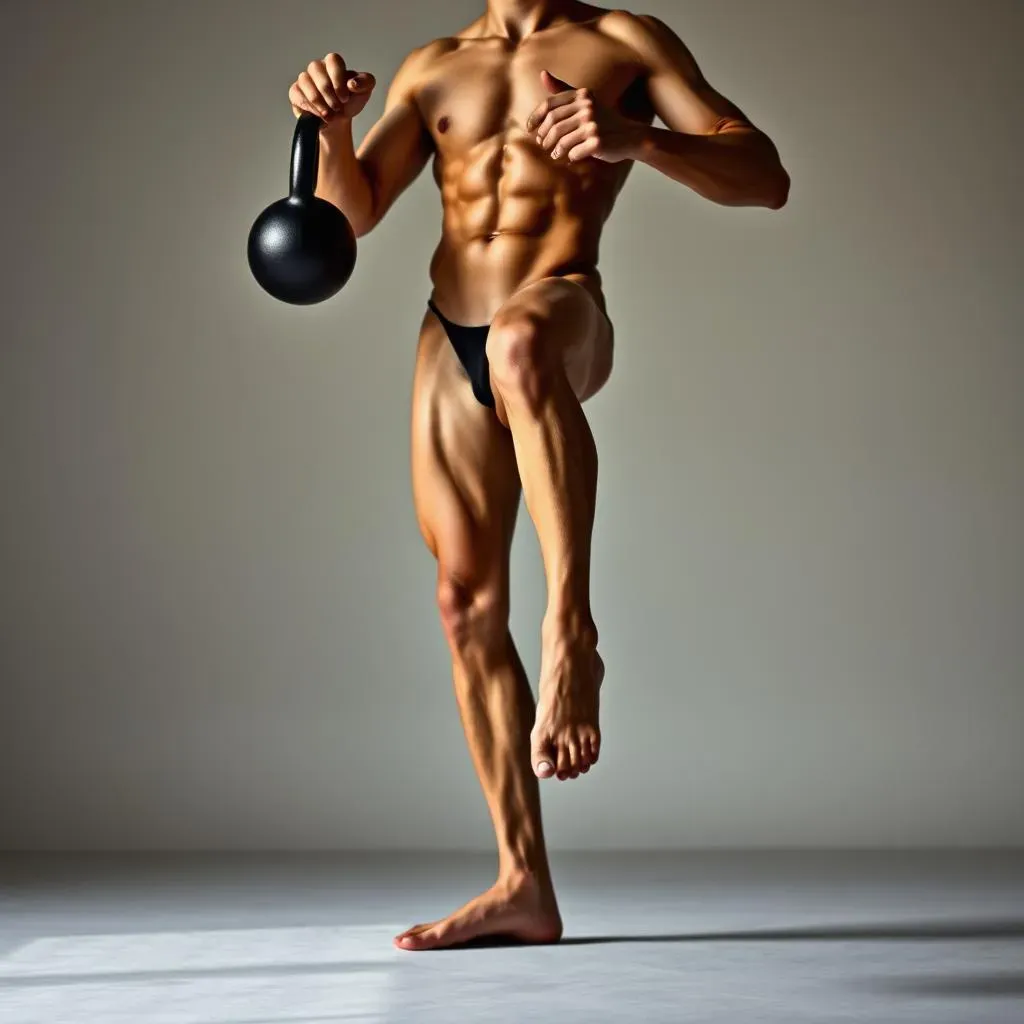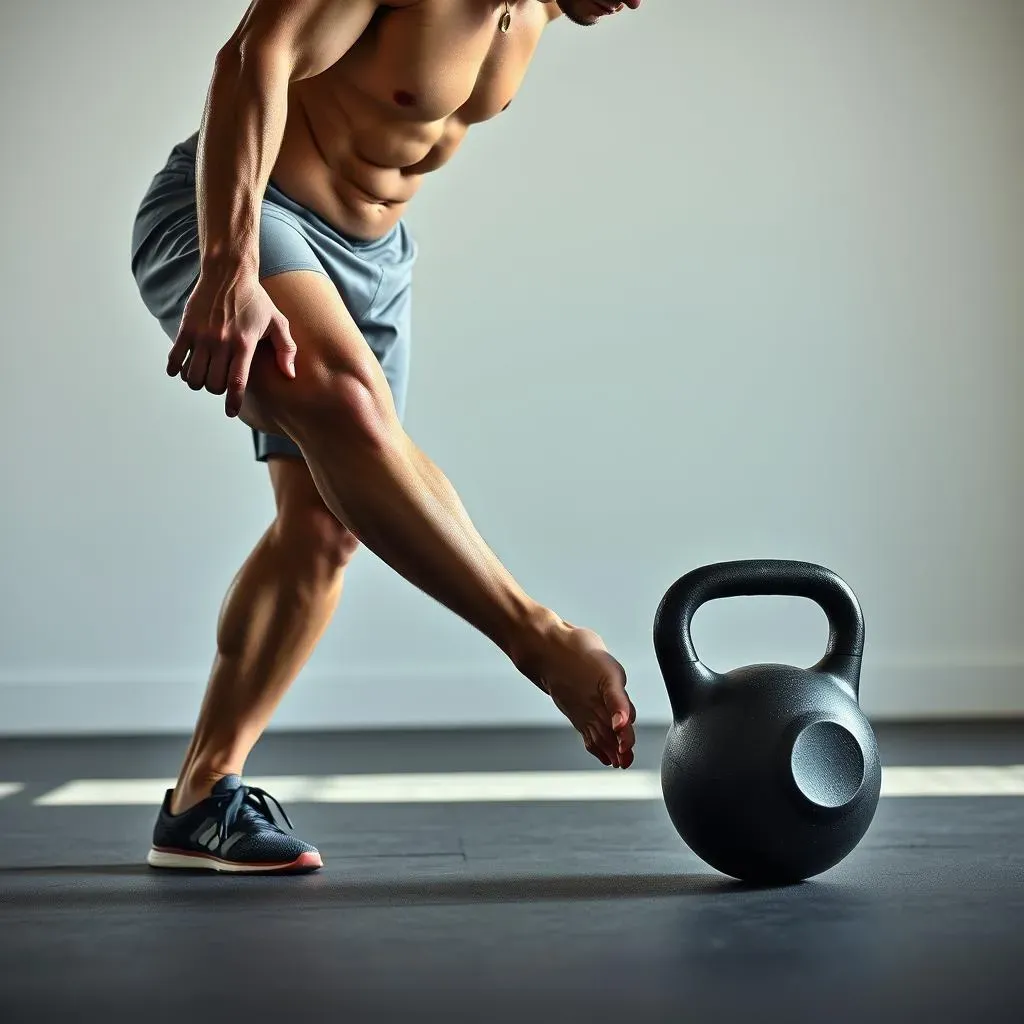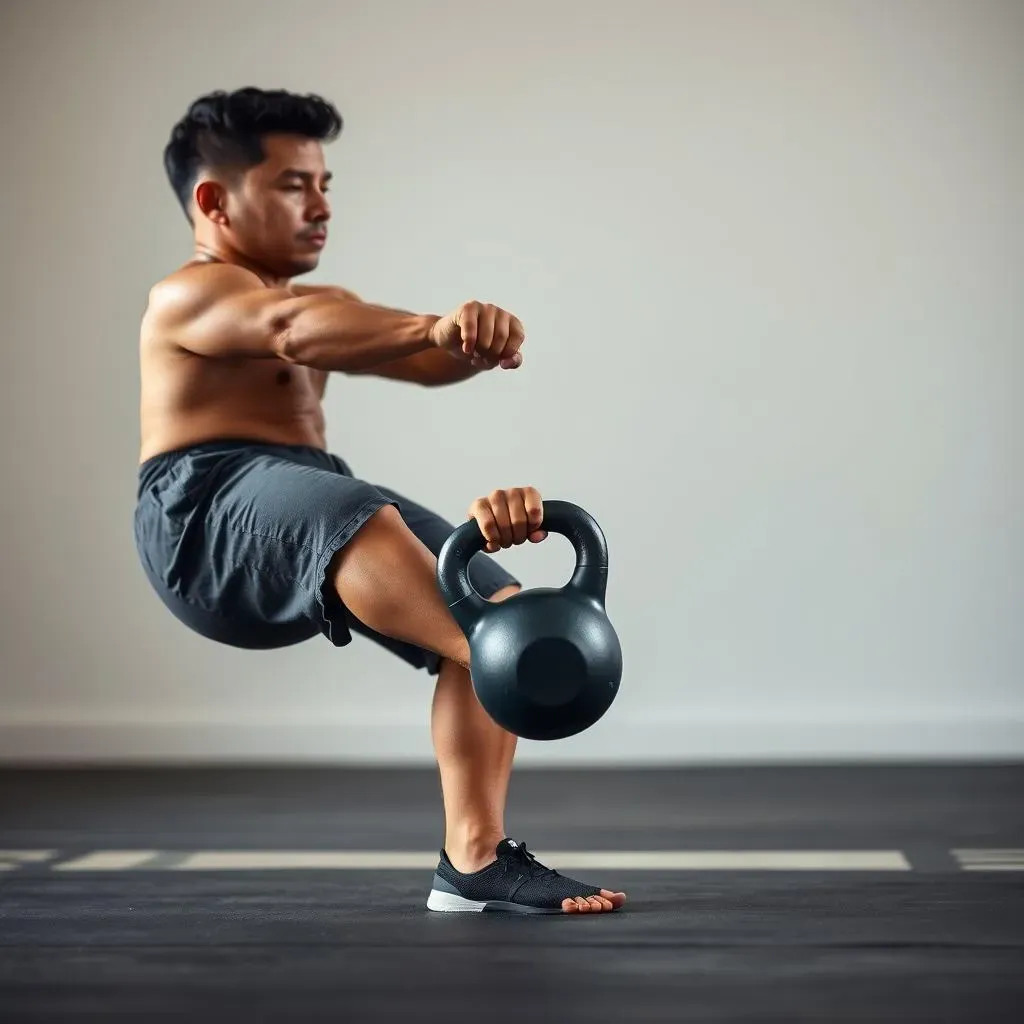Table of Contents
Ever feel like one leg is secretly stronger than the other? That’s where single leg kettlebell exercises come in! Forget those boring, two-legged squats for a second. We're talking about a whole new level of challenge, one leg at a time. These moves aren't just about looking cool; they're about building real-world strength, improving your balance, and fixing those sneaky muscle imbalances you didn't even know you had. Think of it like this: you're not just lifting a weight; you're teaching your body to be a smooth, stable machine. In this article, we’ll explore why single leg kettlebell squats and their variations are so awesome, touch on how your brain plays a part, and then dive into five killer exercises that’ll make you feel like a total boss. We’ll cover everything from the Single Leg Deadlift to the Pistol Squat, explaining how each one works to transform your strength and stability. So, ditch the double-leg routine for a bit and let’s get into it!
Benefits of Single Leg Kettlebell Exercises

Benefits of Single Leg Kettlebell Exercises
Why Bother with One Leg?
Okay, so you might be thinking, "Why make things harder by using just one leg?" Well, let me tell you, it's not about being a show-off. It's about being smart with your training. When you’re doing a single leg kettlebell squat, you’re forcing your body to work harder to stabilize. This means you're not just building strength; you're also improving your balance and coordination big time. Think of it like this: you're not just lifting the kettlebell; you're also battling gravity and your own wobbly bits, all at the same time. That extra effort? It’s where the magic happens.
Plus, single leg exercises are awesome for fixing those imbalances. We all have a stronger side, whether we like to admit it or not. If you’re doing regular squats, your stronger leg might be doing a little more work. This can make your imbalances worse. But with single leg work? Your weaker side has to pull its weight, which will make it stronger and more balanced. It's like giving the underdog a chance to shine!
More Than Just Strength
It’s not just about building bigger muscles, either. Single leg kettlebell exercises translate directly to real-life movements. Think about walking, running, or even climbing stairs. All of those movements are done on one leg at a time. By training this way, you're making your body more efficient and less prone to injury. It's like giving yourself a super-powered upgrade for everyday life. The best part? You don't need massive weights to get a great workout. You can get a killer workout with a lighter kettlebell because you're using more muscles to keep yourself stable.
And don't even get me started on the fun factor. There’s something satisfying about nailing a single leg kettlebell squat. It’s like solving a puzzle with your body. You're testing your limits, learning about your body, and getting stronger, all while having a blast. It's not just a workout; it's a chance to see what you're truly capable of.
Benefit | Why it Matters |
|---|---|
Improved Balance | Better stability in daily activities |
Increased Muscle Activation | More efficient strength gains |
Reduced Imbalances | Balanced strength between left and right sides |
Injury Prevention | Stronger muscles and joints |
Single Leg Neurological Considerations

Single Leg Neurological Considerations
The Brain-Body Connection
Okay, so we've talked about the muscles, but let's not forget the real boss here: your brain. When you’re doing a single leg kettlebell squat, it's not just your leg muscles working; it's also a huge brain workout. Your nervous system is like the control center, sending messages to your muscles to keep you balanced and stable. It's like trying to balance a broomstick on your finger, but with way more weight involved. The first few times you try this, your brain is going to be all, "Whoa, what is going on?" It needs time to figure out how to coordinate everything, and that's totally normal.
Think of it like learning a new dance. At first, you're clumsy, tripping over your own feet. But with practice, your brain gets the hang of it, and the movements become smoother and more natural. Same with single leg exercises. The more you do them, the better your brain gets at sending the right signals, making you more stable and coordinated. This is why consistency is key; you're not just building muscle, you're also training your nervous system to be a pro at balance.
Why You Might Feel Wobbly
Now, let's talk about why you might feel like a baby giraffe on roller skates when you first try these. Your nervous system needs to learn how to fire the right muscles at the right time. With single leg exercises, there’s a lot more going on compared to two-legged movements. You’re not just pushing weight; you're also constantly adjusting to keep yourself from falling over. This requires a lot of small, subtle muscle contractions, and your nervous system needs to get used to this new challenge. If you’ve ever felt shaky or unstable, that’s just your nervous system saying, “Hold on, I’m still figuring this out!”
This is also why it’s important to start slow. Don’t jump straight into heavy kettlebells. Begin with bodyweight single leg squats or assisted variations, like holding onto a wall or chair. This gives your nervous system a chance to adapt without getting overwhelmed. Think of it like learning to ride a bike; you wouldn’t start on a mountain bike, right? You’d start with training wheels, and that’s the same principle we should apply here.
Nervous System Aspect | How It Impacts Single Leg Exercises |
|---|---|
Muscle Coordination | Controls which muscles activate and when |
Proprioception | Sense of your body's position in space |
Balance | Keeps you stable and prevents falls |
Programming for Your Nervous System
So, how do you program for your nervous system? Well, it’s all about smart training. Avoid doing too many single leg exercises when you're tired. Your nervous system is more vulnerable when you are tired, and that's when you are more likely to fall or hurt yourself. So, if you're feeling a bit drained, it’s better to focus on simpler exercises or take a rest day. It's better to be safe than sorry, right?
Also, pay attention to how your body feels during and after your workout. If you’re feeling overly sore or shaky, that’s a sign you might have overdone it. Listen to your body, and adjust your training accordingly. It's not about pushing through pain; it's about working smart and consistently. Remember, progress is not always linear, and sometimes, a step back is what you need to take two steps forward. Think of your nervous system like a delicate flower; it needs care and attention to bloom.
5 Single Leg Kettlebell Exercises

5 Single Leg Kettlebell Exercises
Single Leg Deadlift
Alright, let's get into the good stuff! First up, we've got the Single Leg Deadlift. This move is like a magic trick for your hamstrings and glutes. Imagine you're a flamingo, standing tall with one leg slightly bent, and then you're going to hinge at your hips, reaching down towards the floor with your kettlebell. It's not about touching the floor; it's about feeling that stretch in your hamstrings as you go down and then squeezing your glutes to stand back up. This is a controlled movement, so no jerky motions here.
The key to a good single leg deadlift is to keep your back straight and your core engaged. Think about pulling your belly button towards your spine to keep your core nice and tight. If you're new to this, start without any weight, just to get the feel of the movement. Once you're comfortable, add a light kettlebell and go from there. This exercise is all about balance and control, so take your time and don’t rush it. It’s okay to wobble a bit at first; that just means your muscles are working hard.
Bulgarian Lunge
Next on the list is the Bulgarian Lunge, and trust me, it's a real leg burner! You'll need a bench or a chair for this one. Place one foot behind you on the bench, and then lower yourself down until your front knee is at about a 90-degree angle. The kettlebell can be held in front of you, like you're hugging it, or you can hold it down by your side. The important thing is to keep your chest up and your core tight. This is not a race; it's about controlled, deliberate movement.
The Bulgarian Lunge is a fantastic way to work your quads, glutes, and hamstrings. It also challenges your balance and stability, making it a great all-around exercise. If you find it difficult, start with bodyweight and then add weight as you get stronger. It's normal to feel a bit wobbly at first, but with practice, you'll become more stable. Remember, the goal is to go down slow and controlled, not to drop down like a sack of potatoes!
Exercise | Target Muscles | Key Benefit |
|---|---|---|
Single Leg Deadlift | Hamstrings, Glutes, Lower Back | Improves posterior chain strength |
Bulgarian Lunge | Quads, Glutes, Hamstrings | Enhances unilateral leg strength |
Single Leg Clean
Alright, let’s add a little power to the mix with the Single Leg Clean. This exercise is like a dance move meets weightlifting. You start with the kettlebell on the floor in front of you, then you’re going to hinge at your hips, grab the kettlebell, and in one swift motion, pull it up to your chest, catching it in the rack position. The key here is to use your legs and hips to generate power, not your back. It’s like you're trying to throw the kettlebell upward, but you're stopping at chest level.
This move is not for the faint of heart, and it’s important to master the two-legged clean first. Once you are comfortable with the two-legged version, you can try it one leg at a time. This will challenge your balance and coordination even more. Start with a lighter kettlebell and focus on the technique. The single leg clean is a great way to improve your power and explosiveness, but it’s also a great way to show off a little bit.
Single Leg Row
Now, let's work those back muscles with the Single Leg Row. You'll start by hinging at your hips, holding a kettlebell in one hand, with the other hand hanging down. From here, you're going to pull the kettlebell up towards your chest, squeezing your shoulder blades together. It’s like you're trying to pull your elbow to the ceiling. The key is to keep your back straight and your core engaged. Don’t let your back round out; keep it nice and flat.
The single leg row is a great way to strengthen your back and core, while also improving your balance and stability. Start with a light kettlebell and focus on the movement. You should feel the muscles in your back and shoulders working. This is a great exercise to balance out all the pushing movements we do in our daily lives. Remember, it's not about lifting the heaviest weight; it's about doing the exercise correctly and feeling the right muscles working.
Exercise | Target Muscles | Key Benefit |
|---|---|---|
Single Leg Clean | Full Body, Shoulders, Hips | Enhances power and explosiveness |
Single Leg Row | Back, Shoulders, Core | Improves back strength and posture |
Pistol Squat
Last but certainly not least, we have the Pistol Squat. This is the king of single leg exercises, and it's not for the faint of heart! The pistol squat is a full single leg squat, where you go all the way down until your glutes are close to your heel. You start by standing on one leg, extend the other leg out in front of you, and then lower yourself down, keeping your chest up. It's like you're trying to sit on a tiny stool that doesn't exist. This move requires a ton of strength, flexibility, and balance.
Don't worry if you can't do a full pistol squat right away. Start by practicing partial pistol squats, or use a box to sit on. The important thing is to work on your technique and gradually increase your range of motion. The pistol squat is a great goal to work towards, as it represents a high level of lower body strength and control. It’s like the final boss of single leg exercises; once you conquer it, you’ll feel like a true calisthenics champion.
Conclusion to Single Leg Kettlebell Exercises

Conclusion to Single Leg Kettlebell Exercises
So, there you have it—a deep dive into the world of single leg kettlebell exercises. We've covered why these moves are so beneficial, how they challenge your nervous system, and five awesome exercises to get you started. It's not just about lifting weights; it's about building a stronger, more balanced, and more resilient body. These exercises will help you fix imbalances, improve your balance, and get stronger overall. Remember, it's not a race; it's a journey. Take your time, focus on your technique, and enjoy the process. You might be surprised at what your body is capable of.
Start with bodyweight variations, and gradually add weight as you get stronger. Consistency is key; doing a little bit regularly is way better than doing a lot once in a while. And don’t be afraid to ask for help or guidance if you're unsure about anything. There are plenty of resources available to help you learn these exercises safely and effectively. Now, go out there and conquer those single leg kettlebell squats. You got this!
Key Takeaway | Why It Matters |
|---|---|
Start Slow | Build a solid foundation |
Focus on Form | Avoid injuries and maximize results |
Be Consistent | Regular practice leads to progress |
Listen to Your Body | Adjust training as needed |
Wrapping Up Your Single Leg Kettlebell Journey
Alright, you've made it to the end, and hopefully, you're itching to try out these single leg kettlebell exercises. Remember, it’s not a race; start with your body weight, get the form right, and then grab that kettlebell. These moves aren't just about building muscle; they're about building a body that's strong, balanced, and ready for anything. From improving your stability to fixing those pesky imbalances, single leg kettlebell work is a game-changer. So, go ahead, give these exercises a shot, and watch your strength and coordination level up. Your body will thank you, and you might just surprise yourself with what you can achieve on one leg.